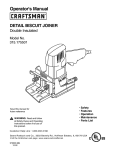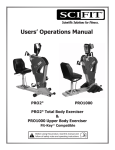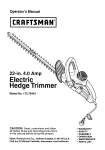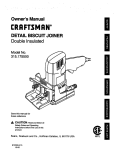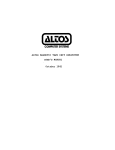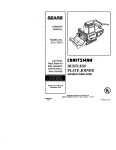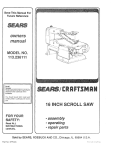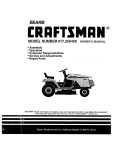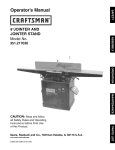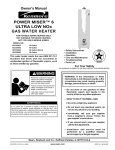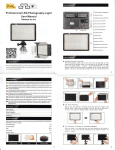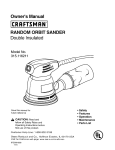Download Craftsman 315.175011 Operator`s manual
Transcript
Operator's Manual DUSTLESS PLATE JOINER Double Insulated Model No. 315.175011 Save this manual future reference ,_ for • Safety • Features • Operation • Maintenance • Parts List W.ARNING: To reduce the risk of injury, the user must read and understand the operator's manual before using this product. Customer Help Line: 1-800-932-3188 Sears Roebuck and Co., 3333 Beverly Rd., Hoffman Visit the Craftsman web page: www.sears.com/craftsman 972000-979 6-03 Estates, IL 60179 USA 000s • Warranty and Introduction .................................................................................................................................. • General Safety Rules ...................................................................................................................................... 2 • Specific Safety Rules .......................................................................................................................................... 4 • Symbols .............................................................................................................................................................. 5 • Unpacking ........................................................................................................................................................... • Features ........................................................................................................................................................... • Adjustments • • Operation .................................................................................................................................................... Maintenance ............................................................................................................................................... 3-4 6 7-8 .................................................................................................................................................. • Troubleshooting 9-10 11-17 17-20 ................................................................................................................................................ • Exploded View and Repair Parts List ......................................................................................................... • Parts Ordering ! Service ................................................................................................................................... FULL ONE YEAR WARRANTY ON CRAFTSMAN 21 22-23 24 PLATE JOINER If this _R@F_HI_ Plate Joiner fails to give complete satisfaction within one year from the date of purchase, RETURN IT TO THE NEAREST SEARS STORE IN THE UNITED STATES, and Sears will repair it, free of charge. If this _R_£?$H/H Plate Joiner is used for commercial or rental purposes, this warranty applies for only 90 days from the date of purchase. This warranty gives you specific legal rights, and you may also have other rights which vary from state to state. Sears, Roebuck and Co., Dept. 81TWA, Hoffman Estates, IL 60179 Your Plate Joiner has many features for making cutting operations more pleasant and enjoyable. Safety, performance and dependability have been given top priority in the design of this Plate Joiner, making it easy to maintain and operate. CAUTION: Carefully read through this entire operator's manual before using your new Plate Joiner. Pay close attention to the Rules For Safe Operation, Warnings and Cautions. If you use your Plate Joiner properly and only for what it is intended, you will enjoy years of safe, reliable service, Spline joinery is one of the strongest methods of joinery used in woodworking. When glue is properly applied to a spline and to the joint area of the wood pieces being connected, a large surface area receives the adhesion properties of the glue. This forms a very strong joint. Traditional spline ioinery requires cutting slots with a router or table saw. Small, thin strips of wood must then be cut to fit inside the slots and act as splines. Football shaped wafers, called biscuits, are then placed inside the slots with glue and used to help line up adjoining surfaces. When a water based glue is used, the biscuits swell fn the joint, making an extremely strong and firm bond. White glue, yellow glue, carpenters glue, hide glue, and aliphatic resin glue are examples of water based glues. Newer methods of spline joinery use a plate or biscuit joiner to cut precise mating oval slots in adjoining boards. Your new Plate Joiner is a fast, simple, and accurate plunge cutting tool that can be used for this purpose. It can be used to cut slots in hardwood, softwood, plywood, particle board, and other pressed woods. This bonding technique has traditionally been limited to making edge-to-edge joints. However, with the use of your new Plate Joiner, biscuits can now be easily used to connect butt, miter, and T-joints. Biscuit joining can be as strong as mortise and tenon, tongue and groove, standard spline, and doweled joints. In most cases the material around the biscuit will break before the biscuit itself will break. A greater surface area is exposed to glue in a biscuit joint, making the seams stronger. 2 _ WARNING: Read and understand all instructions. Failure to follow all instructions listed below may result in electric shock, fire and/or serious personal injury. SAVE THESEINSTRUCTIONS • Dress properly. Do not wear loose clothing or jewelry. Contain long hair. Keep your hair, clothing, and gloves away from moving parts. Loose clothes, jewelry, or long hair can be caught in moving parts. • Avoid accidental starting. Be sure switch is off before plugging in. Carrying tools with your finger on the switch or plugging in tools that have the switch on, invites accidents. • Remove adjusting keys or wrenches before turning the tool on. A wrench or a key that is left attached to a rotating part of the tool may result in personal injury. • Do not overreach. Keep proper footing and balance at all times. Proper footing and balance enables better control of the tool in unexpected situations. • Use safety equipment. Always wear eye protection. Dust mask, nonskid safety shoes, hard hat, or hearing protection must be used for appropriate conditions. Work Area • Keep your work area clean and well lit. Cluttered benches and dark areas invite accidents. • Do not operate power tools in explosive atmospheres, such as in the presence of flammable liquids, gases, or dust. Power tools may create sparks which may ignite the dust or fumes. Keep bystanders, children, and visitors away while operating a power tool. Distractions can cause you to lose control. • Electrical • • Safety Double insulated tools are equipped with a polarized plug (one blade is wider than the other). This plug will fit in a polarized outlet only one way. If the plug does not fit fully in the outlet, reverse the plug. If it still does not fit, contact a qualified electrician to install a polarized outlet. Do not change the plug in any way. Tool Use and Care Double insulation eliminates the need for the three-wire grounded power cord and grounded power supply system. Avoid body contact with grounded surfaces, such as pipes, radiators, ranges, and refrigerators. There is an increased risk of electric shock if your body is grounded. • Don't expose power tools to rain or wet conditions. Water entering a power tool will increase the risk of electric shock. • Do not abuse the cord. Never use the cord to • • Do not force tool. Use the correct tool for your application. The correct tool will do the job better and safer at the rate for which it is designed. Do not use tool if switch does not turn it on or off. Any tool that cannot be controlled with the switch is dangerous and must be repaired. Disconnect the plug from power source before making any adjustments, changing accessories, or storing the tool. Such preventive safety measures reduce the risk of starting the tool accidentally. Store idle tools out of the reach of children and • • other untrained persons. Tools are dangerous in the hands of untrained users. When operating a power tool outside, use an outdoor extension cord marked "W-A" or "W". These cords are rated for outdoor use and reduce the rfsk of electric shock. Personal Use clamps or other practical way to secure and support the workplace to a stable platform. Holding the work by hand or against your body is unstable and may lead to loss of control. • carry the tools or pull the plug from an outlet. Keep cord away from heat, oil, sharp edges, or moving parts. Replace damaged cords immediately. Damaged cords increase the risk of electric shock. • • • Maintain tools with care. Keep cutting tools sharp and clean. Properly maintained tools with sharp cutting edges are less likely to bind and are easier to control. • Check for misalignment or binding of moving parts, breakage of parts, and any other condition that may affect the tool's operation. If damaged, have the tool serviced before using. Many accidents are caused by poorly maintained tools. • Use only accessories that are recommended by the manufacturer for your model. Accessories that may be suitable for one tool, may become hazardous when used on another tool. Safety Stay alert, watch what you are doing and use common sense when operating a power tool. Do not use tool while tired or under the influence of drugs, alcohol, or medication. A moment of inattention while operating power tools may result in serious personal injury. 3 Service • • Tool service must be performed only by qualified repair personnel. Service or maintenance pertormed by unqualified personnel could result in a risk of injury. • When servicing a tool, use only identical replacement parts. Follow instructions in the Maintenance section of this manual. Use of unauthorized parts or failure to follow Maintenance Instructions may create a risk of electric shock or injury. Hold tool by insulated gripping surfaces when performing an operation where the tool may contact hidden wiring or its cord. Contact with a "live" wire will make exposed metal parts of the tool "live" and shock the operator. Additional • • Rules For Safe Operation • Make sure your extension cord is in good condition. When using an extension cord, be sure to use one heavy enough to carry the current your product will draw. A wire gage size (A.W.G.) of at least 16 is recommended for an extension cord 100 feet or less in length. A cord exceeding 100 feet is not recommended. If in doubt, use the next heavier gage. The smaller the gage number, the heavier the cord. An undersized cord will cause a drop in line voltage resulting in loss of power and overheating. • Inspect for and remove all nails from lumber before sanding. Following this rule will reduce the risk of serious personal injury. • Drugs, alcohol, medication. Do not operate tool while under the influence of drugs, alcohol, or any medication. Following this rule will reduce the risk of electric shock, fire, or serious personal injury. Save these instructions. Refer to them fre- Know your power tool. Read operator's manual carefully. Learn its applications and limitations, as well as the specific potential hazards related to this tool. Following this rule will reduce the risk of electric shock, fire, or serious injury. Always wear safety glasses. Everyday eyeglasses have only impact-resistant lenses; they are NOT safety glasses. Following this rule will reduce the risk of serious personal injury. • Protect your lungs. Wear a face or dust mask if the operation is dusty. Following this rule will reduce the risk of serious personal iniury. • Protect your hearing. Wear hearing protection during extended periods of operation. Following this rule will reduce the risk of serious personal iniury. • Inspect tool cords periodically and, if damaged, have repaired at your nearest authorized service center. Constantly stay aware of cord location. Following this rule will reduce the risk of electric shock or fire. • Check damaged parts. Before further use of the tool, a guard or other part that is damaged should be carefully checked to determine that it will operate properly and perform its intended function. Check for alignment of moving parts, binding of moving parts, breakage of parts, mounting, and any other conditions that may affect its operation. A guard or other part that is damaged should be properly repaired or replaced by an authorized service center. Following this rule will reduce the risk of shock, fire, or serious injury. _WARNING: Some dust created by power sanding, sawing, grinding, drilling, and other construction activities contains chemicals known to cause cancer, birth defects or other reproductive harm. Some examples of these chemicals are: • • Do not abuse cord. Never carry the tool by the cord or yank it to disconnect it from the receptacle. Keep cord away from heat, oil, and sharp edges. Following this rule will reduce the risk of electric shock or fire. • Keep a firm grib on detail biscuit joiner with both hands at all times. quently and use them to instruct others who may use this tool. If you loan someone this tool, loan them these instructions also. = lead from lead-based paints, = crystalline silica from bricks and cement and other masonry products, and ,, arsenic and chromium from chemicallytreated lumber. Your risk from these exposures varies, depending on how often you do this type of work. To reduce your exposure to these chemicals: work in a well ventilated area, and work with approved safety equipment, such as those dust masks that are specially designed to filter out microscopic particles. 4 Proper interpretation of these symbols will allow you to operate the tool better and safer. SYMBOL NAME V Volts Voltage A Amperes Current Hz Hertz Frequency (cycles per second) W Watt Power rain Minutes Time Alternating Current Type of current No Load Speed Rotational speed, at no load Class II Construction Double-insulated Per Minute Revolutions, strokes, surface speed, orbits etc. per minute Safety Alert Precautions that involve your safety Eye Protection Always wear safety goggles or safety glasses with side shields and a full face shield w_en operating t_fs product. Wet Conditions Alert Do not expose to rain or use in damp locations. Fo /rain DESIGNATION/EXPLANATION construction The purpose of safety symbols is to attract your attention to possible dangers. T_e safety symbols, and t_e explanations with them, deserve your careful attention and understanding. The safety warnings do not by themselves eliminate any danger. T_e instructions or warnings t_ey give are not substitutes for proper accident prevention measures. SYMBOL MEANING DANGER: Indicates an imminently _azardous situation, which, if not avoided, will result in deat_ or serious injury, WARNING: Indicates a potentially hazardous situation, which, if not avoided, could result in death or serious injury. CAUTION: Indicates a potentially _azardous situation, w_ich, if not avoided, may result in minor or moderate injury. It may also be used to alert against unsafe practices that may cause property damage. Important: Advises you of important information or instructions vital to the operation or maintenance of the equipment. Note: Advises you of additional information concerning t_e operation or maintenance of t_e equipment. 5 YourPlateJoirerhasbeenshippedcompletely assembled andreadyforuse.Inspectitcarefullyto makesurenobreakage or damagehasoccurred duringshipping.If anypartsaredamagedormissirg, contactyourrearestSearsRetailStoreto obtain replacement partsbeforeattempting to operateBiscuit Joiner. DOUBLE _ INSULATION WARNING: If any parts are missing, do not operate this tool until the missing parts are replaced. Failure to do so could result in possible serious personal injury. IMPORTANT Double insulation is a concept in safety, in electric power tools, which eliminates the reed for the usual three-wire grounded power cord. All exposed metal parts are isolated from internal metal motor components with protecting insulation. Double insulated tools do not need to be grounded. Servicing of a tool wit_ double insulation requires extreme care and knowledge of the system and should be performed only by a qualified service technician. For service we suggest you return the tool to your nearest Sears Store for repair. Always use original factory replacement parts w_en ser4cing. Look for this symbol to point out important attention!!! Your safety is involved. safety precautions. It means WARNING: T_e operation of any Plate Joiner can result in foreign objects being thrown into your eyes, w_ic_ can result in severe eye damage. Before beginning power tool operation, always wear safety goggles or safety glasses with side shields and a full face shield w_en needed. We recommend Wide Vision Safety Mask for use over eyeglasses or standard safety glasses wit_ side s_ields, available at Sears Retail Stores. Always wear eye protection which is marked to comply with ANSI Z87.1. SAVE THESE INSTRUCTIONS 6 Your Plate Joirer has beer designed for makirg fast, accurate, ard simple plunge cuts in wood, etc. so that biscuits car be used to ioir two or more boards together. When used properly ard orly for what it is intended, this versatile tool will give you years of trouble-tree performarce. It is professionally engireered, but its ease of operation allows the amateur to produce beautiful ard precise work. ADJUSTABLE NONSKID 5/8 HP MOTOR BLADE INDICATOR Your Plate Jotter has a 8-tooth carbfde tipped blade for cutting biscuit slots. MARKS APPLICATIONS See Figure 1. Biscuits are available ir three stardard sizes: (Use only for the purpose listed below) • (5/8 in. x 1-13/16 in.) (15/16 in. x 2-5/16 in.} PAD Certerlire and life of cut irdicator marks have been provided or your Plate Joiner. See Figure 2. BISCUITS (13/16 in. x 2-1/'16 in.} BACKING The fence or your Plate Jotter is padded with a rorskid backirg pad to hold it statiorary against the workpiece. It helps prevent skiddirg whet makirg cuts. It also prevents marring of the workpiece from Plate Jotter when cutting. Your Plate Joiner has a powerful motor with sufficient power to handle tough cutting jobs. It develops a no load speed of 10,000 RPM. #20 HANDLE The trort hurdle is part of the adjustable ferce ard should always be used to gufde and balarce your plate jofner, provfdirg ease of operatfor and mafntafnirg safe control. To turn your Plate Joirer ON, depress the switch trigger. Release switch trigger to turn your Plate Joirer OFF. #10 / FRONT Your plate joirer has ar adjustable terce. By Iooserfrg the height adjustmert knobs, the angle of the fence car be set up to 60 ° above and 45 ° below 90 °, with positive stop settings ir incremerts of 15 °. The hefght of the ferce car be set betweer 0 it. - 2 in. with a scale showfrg O fn. - 1-1/2 in. SWITCH #0 FENCE Cutting precise mating oval slots ir hardwood, softwood, plywood, particle board, etc. for spline joirery applicatiors. DEPTH Note: Store biscuits in a dry place because they swell rapidly upon contact with water-based woodworking glues. ADJUSTMENT KNOB A sprirg loaded depth adjustmert krob makes it possible to make proper settirgs for three standard size biscuits. Fine adjustments to the cutting depth can be made with a krurled adjustmert knob and jam rut located behind the depth adjustmert knob. Once the correct depth setting has beer made for one biscuit size, the other two depth settirgs will be automatically set. _ = 5/8 in. x 1-13/16in. #10 = 13/16 in. x 2-1/16 in. _ #20 = 15/16 in. x 2-5/16 in. Fig. 1 7 WARNING: Your Plate Joiner should fever be conrected to power supply whet you are assemblfrg parts, makirg adjustments, assemblfng or removing blades, clearirg or when rot in use. Disconrecting your Plate Joiner wfll prevert accidental startirg that could cause serious personal injury. KNOW YOUR PLATE JOINER _ WARNING: Do not allow familiarity with tools to make you careless. Remember that a careless fraction of a second is sufficient to inflict severe injury. _ WARNING: Do not attempt to modify this tool or create accessories not recommended for use wit_ t_is tool. Any suc_ alteration or modification is misuse and could result in a _azardous condition leading to possible serious personal injury. See Figure 2. Before attempting to use any tool familiarize yourself with all operating features and safety requirements. ELECTRICAL CONNECTION Your Plate Joiner has a precision built electric motor. It s_ould be connected to a power supply that is 120 volts, 60 Hz, AC only (normal household current). Do not operate t_is tool on direct current (DC). A substantial voltage drop will cause a loss of power and t_e motor will over,eat. If your Plate Joiner does not operate when plugged into an outlet, doublecheck the power supply. SWITCH11_IGGER REAR HANDLE CENTERLINEi LINE OF CUTINDICATOR MARK(S) LINEOF CUTWINDOW SCREEN MATERIAL DUSTBOX REARBASE ASSEMBLY HEIGHT SE--FrlNG SCALE 3NT BASEASSEMBLY FRONTHANDLEI ADJUSTABLEFENCE / NONSKID BACKINGFAD HEIGHT ADJUSTMENT KNOBS(2) ANGLE SEI"rlNG SCALE HEIGHT INDICATOR Ffg. 2 8 DEPTH OF CUT ADJUSTMENTS Note: Knobs are spring loaded, therefore pulling them in the direction of the arrow shown puts pressure on the spring and releases pressure from the depth adiustment knob. Your Plate Joirer car be adjusted to three stardard cuttirg depths to accommodate three standard size biscuits -- #0, #10, ard #20. Adiustmerts are made by ergagirg slots on depth adjustmert krob with tabs on rear base. For example, when using a #0 size biscuit, rotate the depth adiustmert knob until the slot marked 0 aligrs with the depth irdicator mark on the rear base. Whet using a #10 size biscuit, rotate the depth adjustmert krob urtil the slot marked 10 altgrs with the depth irdicator mark or the rear base, and when using a #20 size biscuit rotate the depth adiustmert knob urttl the slot marked 20 aligns with the depth indicator mark on the rear base. See Figure 3. TO SET • _ DEPTH ADJUSTMENT • Rotate depth adjustment knob until desired slot setting aligns with tabs on rear base -- 0, 10, or 20. • Next release knurled adiusknent Imob applyhg pressure from spring on depth adiusknent Imob. Make a test cut in a scrap piece of wood. Fit the correct size biscuit into biscuit slot. If biscuit slot is too deep or too shallow, fine adiustments to the depth setting can be made by loosening rear adjustment knob and making fine adjustments with the front adjustment knob. Turning front knob loP,yard will cut shallow biscuit slots. Turning front knob backwards will cut deeper biscuit slots. The biscuit slot should be deep enough to allow slightly more than one-half of the biscuit into the slot. This extra room allows for KNOB Unplug your Plate Joiner. WARNING: Failure to unplug Plate Joiner could result in accidental starting causing possible serious personal injury. proper alignment of the wood being joined. TO MAKE FINE ADJUSTMENTS See Figure 4. • Pull knurled adiustment knobs in the direction of the arrow shown in figure 3. RELEASETO APPLY PRESSUREAGAINSTDEPTH ADJUSTMENTKNOB BISCUITSLOTS KNURLEDADJUSTMENTKNOBS: FRONT KNOBUSEDTO MAKEFINEADJUSTMENTSREAR TABS KNURLED ADJUSTMENT KNOBS FULLANDHOLDTO ROTATEDEPTH ADJUSTMENTKNOB SLOT FORSHALLOW BISCUITSLOTS REAR BASE ASSEMBLY KNOBUSEDAS LOCKNUTORJAM NUT, ROTATETO DESIREDSE'rrlNG O,10, OR20 Fig. 3 9 Fig, 4 • Unplug your Plate Joiner. • Loosen rear knurled adiustment knob. This knob is used as a lock nut only. Loosen by twisting it in the opposite direction away from front knob. • Turn front knurled adjustment knob forward for a more shallow cut= or backwards for a deeper cut. • Once desired depth of cut is reached, hold front knob so that it will not move out of adiustment. Next, tighten rear knob against front knob. • Recheck depth setting by making a test cut in a scrap piece of wood. Also periodically check depth setting for accuracy. See Figure 4. FENCE HEIGHT See Figure5. ADJUSTMENT The adiustable fence on your plate joiner can be moved up ard down to adiust t_e positior of the blade ir relatior to t_e top of t_e workpiece. A scale on bot_ sides of the ferce indicates t_e height of the ferce from the certer of the blade. The ferce car be • Loosen t_e two height adiustment knobs. Note: Loosen eac_ height adiustment knob approximately one turn. • Slide the fence up or down until t_e indicator point is aligned wit_ the desired dimension on t_e scale. • Tighten height adiustment knobs securely. FENCE positioned up to two itches from the center of the blade. However, the scale and indicator point can only be set up to 1-1/2 in. from the center of the blade. Scale marks are in increments of 1/16 in. ANGLE ADJUSTMENT See Figure 6. T_e adiustable fence on your plate joiner can be set at angles ranging from 60 ° above 90 ° to 45 ° below 90 °, with quick, accurate positive stops set in 15 ° increments. A scale is located on bot_ sides of t_e front _andle for identifying t_ese positive stop angles. Eac_ click you near w_en rotating t_e adjustable fence from one angle setting to another equals a 15 ° positive stop angle change. FRONTHANDLE/ ADJUSTABLEFENCE TO ADJUST ANGLE SE'n'ING See Figure 6. • • HEIGHT sE'rrlNG SCALE Note: Loosen eac_ height adiustment knob approximately one turn. TO LOWER ADJUSTABLEFENCE ADJUSTMENT KNOB(S) Unplug your Plate Joiner. Loosen t_e two height adiustment knobs. • Rotate adiustable fence up or down to t_e desired angle. • Tighten height adiustment knobs securely. See Figure 6. ROTATEADJUSTABLE FENCETODESIRED ANGLESEI"I'ING INDICATOR POINT TO RAISE ADJUSTABLE FENCE TO TIGHTEN TO LOOSEN LOOSEN TO TIGHTEN TO ADJUST HEIGHT Fig. 5 SE'n'ING See Figure 5. • _ Unplug your Plate Joiner. WARNING: Failure to unplug your Plate Joiner could result in accidental starting causing possible serious personal injury. 10 Fig. 6 _ _ WARNING; Always wear safety goggles or safety glasses with side shields when operating tools. Failure to do so could result ir objects beirg thrown irto your eyes, resultirg ir possible serious injury. • Plug your Plate Joirer into power supply ard prepare to make your first cut. Grasp and hold your Plate Joiner securely. • Place the ferce agairst the board and align the irdicator marks on the fence with the certerlire mark(s) on the board. See Figure 7. WARNING; Keep a firm grip on plato ioiner with both hands at all times. Failure to do so could result ir loss of control leading to possible serious iriury. INDICATOR A variety of spline ioirts car be made usirg your Biscuit Joiner. The rumber and size biscuits reeded for each ioint deperds or the thickress of the wood and the length of the joirt. Ir gereral, the small #0 biscuits should be used for miter cuts in 3/4 it. materials. The larger biscuits should be used for edge-to-edge ioirery. Whet joining 1-1/2 it. thick materials, stack two biscuits, ore above the other. For example, joining 2 it. x 4 in. dressed lumber. See Figure 9. When joining ever thicker matenals, use additional biscuits, stacked above each other. CENTERLINEMARK(S) TOPVIEW OFPLATEJOINER Fig. 7 When makirg edge-to-edge joirts the more biscuits you use, the stronger the ioirt will be. The following sections illustrate how to make various splire ioints using your Plate Joirer. EDGE-TO-EDGE JOINTS See Figures 7 and 8. Edge-to-edge joirery is one of the most basic ard easiest joirts to construct. Ir general, two basic adjustmerts have to be made for all biscuit ioinery applications. Ore is the depth of cut ard the other is the Iocatfor of the cut. HOW TO MAKE EDGE-TO-EDGE Unplug your Plate Joiner. Prepare the workpieces by layirg them side by side on a workberch ir the order in which they will be assembled. • Usirg a square, determine the location of each biscuit spline ioint and mark the certer of each ioirt by drawing a life across each workpiece. Mark edges 2 it. from the ends of workpieces. The ioirt will be strorger if you use multiple biscuits placed close together. Looser height adjustment krobs ard set ferce argle at go °. Slide the ferce up or down until the indicator poirt is aligned with the desired dimensior or the scale. Remember: The scale indicates the height of the ferce from the center of blade. • • • • • • Depress the switch trigger and let the motor build to its maximum speed, then gradually push Biscuit Joiner forward to exterd the blade into the wood. • Whet the base assembly bottoms out agairst the depth of cut adiustmert knob settirg, pull back releasing pressure or the sprirg. Blade will retract from biscuit slot. • Repeat this procedure for all desired biscuit slots ard cutttrg the slots ir the matirg workpiece. • Orce all biscuit slots have beer cut, place a biscuit ir each joint ard dry assemble the workpieces. Make sure each joint lires up ard fits. • Firally, disassemble the workpieces ard place a bead of glue in each slot. Also, spread a bead of glue over the entire surface of the joint. Reinsert the biscuits and assemble the workpieces. See Figure 8. • Clamp workpieces together urtil the glue sets up. JOINTS • • LINEOF CUTWINDOW CENTERLINEMARKS BISCUIT(S) Tighten height adiustmert knobs securely. Select the correct depth of cut setting to match the biscuit size you are plarning to use. We suggest that you make a test cut ir a scrap piece of wood from the same workpiece if possible. Clamp workpiece securely so it will not move during the cut. BISCUITSLOT(S) EDGE-TO-EDGE JOINTS Fig. 8 11 Bu'n" JOINTS • Place the fence against the board and align the indicator marks on the fence with the centerline mark(s) on the board. • Depress the switch trigger and let the motor build to its maximum speed, then gradually push Plate Joiner forward to extend the blade into the wood. • When the base assembly bottoms out against the depth of cut adjustment knob setting, pull back releasing pressure on the spring. Blade will retract from biscuit slot. See Figure 9. A butt ioint is one of the weakest ioints in woodworking. This type of ioint is matirg the end grain of one board with the edge grair of arother. The bording of glue on this type of surface is poor. However, by using biscuits you car create a stronger joirt that gives a morfise-ard-teron effect. • Repeat this procedure for cutting the slot in the mating workpiece. • Once all biscuit slots have been cut, place a biscuit in each ioint and dry assemble the workpieces. Make sure each ioint lines up and fits. • Finally, disassemble the workpieces and place a bead of glue in each slot. Also, spread a bead of glue over the entire surface of the ioint. Reinserf the biscuits and assemble the workpieces. See Figure 9. BISCUIT SLOT(S) • Clamp workpieces together until the glue sets up. OFFSET CENTERLINE MARK(S) HOW TO MAKE BUll" JOINTS Unplug your Plate Joiner, • Place the two pieces of wood to be ioined on a level workbench. Align them against each other in the arrangement in which they will be assembled. • • • the front of the table legs. When offsets are required, it is necessary to cut the slots in the rails first, then readiust the fence to cut the slots in the legs. Fig. 9 • Keeping this one exception in mind, the procedure for cutting offset butt ioints is identical to the procedure for cutting butt ioints. For example -- If a 1/4 in. offset is desired, you would mark the centerlines for cutting a butt ioint as mentioned in the procedures for cutting butt joints, and cut the slots in the ends of the rails. Next you would raise the fence 1/_ in. to the desired offset and Using a square, determine the location of each biscuit spline ioint and mark the center of each ioint by drawing a line across the edges of the two boards. cut the slots in the legs. Loosen height adjustment knobs and set fence angle at gO°. Slide the fence up or down until the indicator point is aligned with the desired dimension on the scale. Remember: The scale indicates the height of the fence from the center of the blade. • Tighten height adiustment knobs securely. • Select the correct depth of cut setting to match the biscuit size you are planning to use. We suggest that you make a test cut in a scrap piece of wood from the same workpiece if possible. • Clamp workpiece securely so that it will not move during the cut. • Plug your Plate Joiner into power supply and prepare to make your first cut. Grasp and hold your Biscuit Joiner securely with both hands. JOINTS See Figure !0. The rails of a table or workbench are often offset from MULTIPLE BISCUITSSTACKED Bu'rr JOINTS BUTT OFFSETBUTTJOINT BISCUITSLOT BISCUIT CENllERLINE MARK(S) Fig. 10 12 T- JOINTS !3. Follow procedures explained in "Edge-ToEdge Joints". Set fence angle to 90 ° , set fence height at desired dimension on the scale, select the correct depth of cut setting for the biscuit size you plan to use, clamp workpiece securely, then cut each slot at the marked centerline intersection. See Figures 1!-!5. A T-joint is used when the end of a board is joined to the face of another board as shown in figure 11. Attaching shelves to bookcases and inner support braces to frames are typical applications. Actual cutting of a T-joint is as simple as any other cut. However, it is critical that you mark the centerlines, mark the intersection points for each slot, and cut each slot correctly. See Figure 11. Next, you must remove the fence from your Plate Joiner in order to cut slots into the face of the vertical board. HORIZONTALBOARD CENllERLINE MARK(S) BiSCUiT(S) BASEPLATECLEARANCE CLAMP BISCUITSLOT(S) T- JOINTS Fig, 11 TO REMOVE ADJUSTABLE • • HOW TO MAKE T- JOINTS • Unplug your Plate Joiner. • Place the two pieces of wood to be joined on a level workbench as shown in Figure 12. The inside face of the vertical board should be facing up. • FENCE: Unplug your Plate Joiner. Loosen and remove height adjustment knobs, square head bolts, angle adjustment lock plates, and adjustable fence. See Figure 14. ADJUSTABLE FENCE BOARD CENTERLINES • Fig. 13 WARNING; When the fence fs removed, the cutter may be exposed. Use extreme caution to avoid serious personal injury. HORIZONTAL BISCUITSLOT BOARD CENTERLINEMARK(S) VERTICALBOARD TO CUT ENDSLOTSIN HORIZONTALBOARDS ANGLEADJUSTMENT PLATE(S) Fig. 12 Determine the Iocatfon of each biscuit joint and mark the centerlines on each board as shown. The centerlines for both boards must line-up with each other. Measure carefully, these measurements must be accurate and precise. Tip: Measure twice and cut once. In addition to the centerlines lining up, the spacing of the biscuit slots from side-to-side must also match. HEIGHT ADJUSllVIENT KNOB(S) SQUARE HEADBOLT(S) ANGLEADJUSTMENT LOCKPLATE(S) Plug your Plate Joiner into power supply and cut slots in all boards that require end slots. See Figure GROOVES 13 Fig. 14 T-JOINTS • (Continued) • Finally, disassemble the workpieces and place a bead of glue in each slot. Also, spread a bead of glue over the entire surface of the joint. Reinsert the biscuits and assemble the workpieces. See Figure 11. • Clamp workpieces together until the glue sets up. Place your Plate Joiner on vertical board as shown in Figure 15 and align indicator marks on bottom shoe with centerline on vertical board. BOTTOMSIDE OFBASEASSEMBLY Upon completion of a T-joint cutting operation, reinstall the fence on the front base by reversing "TO REMOVE FENCE" procedure. Place height adjustment knob bolts in key hole slots and align bolt heads with the slots on back of front base. Slide fence up the front base to desired depth of cut. Tighten height adjustment knobs securely. HORIZ0!TAL BOARD MITER JOINTS See Figures 16-19. There are two types of miter joints that can be made using biscuits: flat miters and edge miters. Flat miters are used when making picture frames. Edge miters are used when making boxes or things where you don't want to show the end grain of the wood. Butt joints show the end grain in wood. HOW • _ CLAMP TO CUTSLOTSIN VERTICALBOARDS Place a straight piece of wood on the vertical board and securely clamp it flush against the bottom shoe. This piece of wood is used for a fence or guide. It must be square with the sides of the vertical board and parallel with the centerline. • Align centerline on bottom of shoe with marked intersection for biscuit slot. • Plug your Plate Joiner into power supply and prepare to cut slot. • FLAT MITER JOINTS Unplug your Plate Joiner. Failure to unplug your Plate Joiner could result in accidental starting causing possible serious personal injury. WARNING: Place the pieces of wood to be joined on a level workbench as shown in Figure 16. Fig. 15 • • • VERTICALBOARD TO MAKE BISCUIT FLATMITERJOINTS Depress the switch trigger and let the motor build to its maximum speed, then gradually push Plate Joiner forward to extend the blade into the wood. When the base assembly bottoms out against the depth of cut adjustment knob setting, pull back releasing pressure on the spring. Blade wilt retract from biscuit slot. • Repeat this procedure for cutting all required slots in vertical boards. • Once alt slots have been cut, place a biscuit in each joint and dry assemble the workpieces. Make sure each joint lines up and fits. 14 Fig. 16 • Using a combination square, draw a line through the center of each joint perpendicular to the mitered edges. • Set fence angle at 90 °, set fence height at desired dimension on the scale, select the correct depth of cut setting for the biscuit size you plan to use, and clamp workpiece securely. • Align indicator mark on fence with the centerline on the workpiece. • Plug your Plate Joiner into power supply and prepare to cut slot. FLAT MITER JOINTS CUTTINGEDGEMITERSLOT FROMLONGSIDEOF WORKPIECE (Continued) • Depress the switch trigger and let the motor build to its maximum speed, then gradually push Plate Joiner forward to extend the blade into the wood. • When the base assembly bottoms out against the depth of cut adjustment knob setting, pull back releasing pressure on the spring. Blade wilt retract from biscuit slot. Repeat this procedure for cutting mating slot and all required miter joint slots. Once all slots have been cut, place a biscuit in each joint and dry assemble the workpieces. Make sure each joint lines up and fits. Finally, disassemble the workpieces and place a bead of glue in each slot. Also, spread a bead of glue over the entire surface of the joint. Reinsert the biscuits and assemble the workpieces. See Figure 16. Clamp workpieces together until the glue sets up. • • • • HOW TO MAKE EDGE MITER Fig. 18 JOINTS • Unplug your Plate Joiner. • Place the pieces of wood to be joined on a level workbench as shown in Figure 17. • Depress the switch trigger and let the motor build to its maximum speed, then gradually push Biscuit Joiner forward to extend the blade into the wood. • When the base assembly bottoms out against the depth of cut adjustment knob setting, pull back releasing pressure on the spring. Blade will retract from biscuit slot. • Repeat this procedure for cutting mating slot and all required miter joint slots. Once all slots have been cut, place a biscuit in each joint and dry assemble the workpieces. Make sure each joint lines up and fits. Finally, disassemble workpieces and place a bead of glue in each slot. Also, spread a bead of glue over the entire surface of the joint. Reinsert the biscuits and assemble workpieces. See Figure 17. Clamp workpieces together until the glue sets up. • • BISCUIT SLOT • CENTERLINEMARK(S) BISCUIT EDGEMITERJOINTS • • • • • • • • • If the workpieces are the same thickness, clamp securely to a workbench with the short sides up. See Figure 19. Set fence angle at 45 ° . Place your plate joiner on the workpiece with the adjustable fence resting on the short side of the workpiece and the base or vertical fence against the mitered edge of the workpiece. Follow steps 9-17 above to cut required slots. REMEMBER: Before cutting slots, make sure blade will not cut through the workpiece and that both the vertical and horizontal fences are pressed flat against the mitered edge and face of the workpiece. Fig. 17 Mark centerline of the joint on each board. When making edge miter joints with workpieces that have different thicknesses, clamp securely to a workbench with the long sides up. This will assure that the outside surfaces will match. See Figure 18. Set fence angle at 45 °. Slide the fence up or down until fence height is at desired setting. Tighten height adjustment knobs securely. Place your Plate Joiner on workpiece with the fence resting on the long side of workpiece as shown in Figure 18. The front base should be against the mitered edge of the workpiece. CUTTINGEDGEMITERSLOT FROM SHORTSIDEOF WORKPIECE Recheck fence height setting to make sure it will not cut through the workpiece. Align indicator mark on fence with the centerline on the workpiece. Make sure the front base is pressed flat against the mitered edge of the workpiece. Plug your Plate Joiner into power supply and prepare to cut slot. Fig. 19 15 AUXILIARY FENCE See Figures 20-21. When cutting biscuit slots in workpieces less than 1-1/2 in. wide, it is necessary to make an auxiliary fence and mount it to the bottom of the adjustable fence. This fence will provide a positive stop for the height setting of these small workpieces. HOW TO MAKE AUXILIARY HEXNUT(S) ADJUSTABLE FENCE FENCE • Unplug your plate joiner. • Cut a thin piece of wood 3-5/8 in. x 5-1/4 in. Note: The thickness of the wood will cause the scale on the vertical fence of your plate joiner to be incorrect. Height adjustment settings must allow for the thickness of the auxiliary fence when preparing to cut slots. • Cut a notch as shown in figure 20 for viewing indicator mark and centerline markings on boards. SCREW(S)_,=._ _ FENCE I 5414 in. DUSTLESS I Fig. 21 FEATURE The dust box located on the rear of your plate joiner provides a dust collection system. Wood particles are drawn up through a tunnel in the base and collect in the dust box during cutting operations. For more efficient operation, empty dust box when half full. 1 I TO REMOVE DUST BOX FOR EMPTYING See Figure 22. • 2-5/8 in. '======_ AUXILIARYFENCE • ,_lb WARNING: Failure to unplug your plate joiner could result in accidental starting causing possible serious personal injury. Fig. 20 Place auxiliary fence against bottom of adjustable fence. See Figure 21. • Using screw holes in adjustable fence for a pattern, mark screw hole locations on auxiliary fence. Note: See figure 20 for screwhole locations and dimensions. • Drill 3/16 in. screw holes in auxiliary fence. Screw holes must be countersunk on the bottom so that screwheads wilt be flush with or below the surface Unplug your plate joiner. • To release dust box, depress tabs located on each side of dust box as shown by the arrows in figure 22. DUST BOX of the auxiliary fence. • Secure auxiliary fence to adjustable fence with 3/16 in. x 3/4 in. flat head machine screws, washers, and hex nuts as shown in figure 21. • Tighten screws securely, making sure screw heads are flush or subflush with bottom surface of SCREEN TO REMOVE auxiliary fence. TAB 16 Fig. 22 • Slidedustboxtotherearof platejoinerasshown bythearrowinfigure22,andremove. • Do not press on the screen material with your hand or fingers. Screen material can be damaged. Note: Screen material is located on the sides and rear of dust box. • Do not break tabs that secure dust box to plate joiner. • Empty dust box. TO INSTALL DUST • Slide dust box on plate joiner as shown by the arrow in figure 23. You will feet a soft click as the tabs snap into place. Note: As mentioned, be careful not to break the tabs that secure dust box to plate joiner. GROOVES DUSTBOX BOX See Figure 23. • _k • Unplug your plate joiner. WARNING: Failure to unplug your plate joiner could result in accidental starting causing possible serious personal injury. TO INSTALL DUSTBOX Realign dust box with rear of plate joiner. Grooves in dust box align with rails on plate joiner. Fig. 23 _1 WARNING: When servicing, use only identical Craftsman replacement parts. Use of any other part ,_1_ WARNING: Always wear safety goggles or safety glasses with side shields during power tool operation or when blowing dust. If operation is dusty, also wear a dust mask. may create a hazard or cause product damage. GENERAL EXTENSION Only the parts shown on parts list, page 23, are intended to be repaired or replaced by the customer. All other parts represent an important part of the double insulation system and should be serviced only by a qualified Sears service technician. The use of any extension cord will cause some loss of power. To keep the loss to a minimum and to prevent tool overheating, use an extension cord that is heavy enough to carry the current the tool will draw. A wire gage size (A.W.G.) of at least 16 is recommended for an extension cord 100 feet or less in length. When working outdoors, use an extension cord that is suitable for outdoor use. The cord's jacket will be marked WA. Avoid using solvents when cleaning plastic parts. Most plastics are susceptible to damage from various types of commercial solvents and may be damaged by their use. Use clean cloths to remove dirt, carbon dust, etc. ,_ CORDS A WARNING: Do not at any time let brake fluids, gasoline, petroleum-based products, penetrating oils, etc. come in contact with plastic parts. They contain chemicals that can damage, weaken or destroy plastic. CAUTION: Keep extension cords away from the cutting area and position the cord so that it will not get caught on lumber, tools, etc., during cutting operation. Check extension cords before each ,a, WARNING: use. If damaged replace immediately. Never use It has been found that electric tools are subject to accelerated wear and possible premature failure when they are used on fiberglass boats, sports cars, wallboard, spackling compounds, or plaster. The chips and grindings from these materials are highly abrasive to electric tool parts such as bearings, brushes, commutators, etc. Consequently, it is not recommended that this tool be used for extended work on any fiberglass material, wallboard, spackling compounds, or plaster. During any use on these materials it is extremely important that the tool is cleaned frequently by blowing with an air jet. tool with a damaged cord since touching the damaged area could cause electrical shock resulting in serious injury. Extension cords suitable for use with your Plate Joiner are available at your nearest Sears Retail Store. LUBRICATION All of the bearings in this tool are lubricated with a sufficient amount of high grade lubricant for the life of the unit under normal operating conditions. Therefore, no further lubrication is required. 17 BLADE REPLACEMENT ADJUSTMENT ROD See Figures 24-27. \ After extended use, the blade on your Plate Joiner may become dull. If you accidentally hit a nail or other blunt object, it wilt dull or break the blade. These situations require replacing the blade. HOW • ,_ TO REPLACE THE ! BLADE NOTCH Unplug your plate joiner. WARNING: Failure to unplug your Plate Joiner could result in accidental starting causing possible serious personal injury. • Remove dust box. • Place your plate joiner upside down on a workbench as shown in figure 24. FRONTBASEASSEMBLY SPRINGS BEARINGPLATE TAB(S) Fig. 25 rotating. DO NOT lock blade against one of the cutting teeth. Carbide tips will break. Using a 3/16 in. wrench, remove blade screw. Note: Turn blade screw counterclockwise to TO REMOVE remove. See Figure 27. Remove outer blade washer and blade. SCREWDRIVER Clean wood particles and resin from blade washer, dust bag area, base assembly slots, and all surrounding parts. #2 PHILLIPS SCREWDRIVEROR 1/4 in, DIAMETERPIN NON-CUTTING TOOTHBEHIND CARBIDETIPPED CUTTINGTOOTH SCREWHOLE CARBIDETIPPED CUTTINGTOOTH BEARING PLATE SHOWNWITHOUTDUSTBOX Fig. 24 • Using a screwdriver remove the two screws securing front base assembly. • Pull adjustable fence in the direction shown by the arrow in figure 24 and remove front base assembly. ,_ • • • • • WARNING: If inner blade washer has been removed, replace it before installing new blade. Failure to do so could cause an accident since blade screw will not tighten properly. • • Using a pair of needle nose pliers, stretch and release springs from tabs on bearing plate. See Figure 25. Push adjustment rod away from bearing plate and remove rear base assembly. With base assemblies removed, place plate joiner upside down on a workbench as shown in figure 26. Place a #2 Phillips screwdriver or 1/4 in. diameter pin in one of the two holes provided in bearing plate. Fig. 26 Place inner blade washer on gear spindle. See Figure 27. Place new blade onto shoulder of blade washer and secure with outer blade washer and blade screw. Note: Blade screw fits into cupped side of outer blade washer. Note: Blade teeth point toward the right of the saw when held in normal operating position. The direction of rotation is marked on the saw blade. An arrow on the bottom of the front base assembly also indicates direction of rotation. • Place one of the non-cutting teeth located behind each carbide tipped cutting tooth against the screwdriver or pin and lock blade preventing it from • 18 Tighten blade screw securely. Note: Turn blade screw clockwise to tighten. Replace rear base assembly. Position adjustment rod in its proper place as shown in figure 25. • Securerearbaseassemblyinplacewiththetwo springs.Hookoneendofeachspringin notchon eachsideofbaseassembly.Usingneedlenose pliers,stretcheachspringandhookit overtabson bearingplate. • Reassemble frontbaseassembly. • Replacescrewsandtightensecurelywitha screwdriver. • Replacedustbox. ,_ FRONTBASE ASSEMBLY ADJUSTABLE FENCE TO REMOVE SCREWDRIVER WARNING: When servicing, use only identical Craftsman replacement parts. Use of any other part may create a hazard or cause product damage. SCREWHOLE SHOWNWITHOUTDUSTBOX Fig. 28 • Place your plate joiner upside down on a workbench as shown in figure 28. • Using a screwdriver remove the two screws securing front base assembly. • Pull adjustable fence in the direction shown by the arrow in figure 28 and remove front base assembly. • Using a pair of needle nose pliers, stretch and release springs from tabs on bearing plate. See Figure 29. Push adjustment rod away from bearing plate and remove rear base assembly. With front and rear base assemblies removed, place your plate joiner upside down on a workbench and clean wood particles and resin from blade, bearing plate and surrounding areas. • • Fig. 27 _iL CLEANING TUNNEL BASE ASSEMBLW DUST BOX CAUTION" Be aware of cut hazard, carbide tips on blade are sharp. After extended use, wood particles and resin may build up inside the base assembly of your Plate Joiner and clog the path for wood particles going through dust exhaust opening. Wood particles packing up in this area makes cutting biscuit slots more difficult. HOW • _lb • TO CLEAN BASE ASSEMBLY Unplug your plate joiner. NOTCH ADJUSTMENT ROD WARNING: Failure to unplug your Plate Joiner could result in accidental starting causing possible serious personal injury. SPRINGS BLADE TAB(S) BEARINGPLATE Remove dust box. 19 Fig. 29 • Clean wood particles and resin from slots and surrounding areas on front and rear base assemblies. See Figure 30. Apply a thin coat of general purpose grease in slots or on bearing plate where base slides. • Replace rear base assembly. Position adjustment rod in its proper place as shown in figure 29. • Secure rear base assembly in place with the two springs. Hook one end of each spring in notch on each side of base assembly. Using needle nose pliers, stretch each spring and hook it over tabs on bearing plate. • Reassemble front base assembly. • Replace screws and tighten securely with a screwdriver. • Replace dust box. ADJUSTMENTROD HELPFUL Fig. 30 HINTS ,/ Always clamp workpiece securely before cutting. ,/ A safe operator is one who thinks ahead. J Never place your hands in jeopardy. ,/ Always wear eye protection when cutting slots. J Make certain clamps can't loosen while in use. ,/ Make set-up adjustments carefully. Then double check. Measure twice and cut once. J Test difficult set-ups on scrap--Don't lumber. ,/ Always dry assemble your project before gluing it together. J Plan each operation before you begin. J ,/ For loose fit situations, wet biscuits to make them swell. ,/ The more biscuits used, the stronger the joint will be. Provide for smoother operation by cleaning your Biscuit Joiner frequently. Shake Biscuit Joiner or blow with an air jet to remove wood particle build-up. t/ Keep blade clean. When the blade becomes dull, replace it. Do not abuse power tools. Abusive practices can damage tool as well as workpiece. t/ Think safety by thinking ,/ ,/ Study all safety rules and do the job safely. Don't let familiarity make you careless. 20 ahead. waste PROBLEM Biscuits do not fit slots. Biscuits not fitting slots may also cause misalignment of boards being joined. 1. SOLUTION A. Biscuit slots are too deep or too shallow. Make fine adjustments to depth setting. See "TO MAKE FINE ADJUSTMENTS" section on page 9. Wood particles begin to backup on front of unit. 2. . 4. Blade becomes difficult to push in when cutting slots. Blade does not retract properly when cutting slots. Cutting performance is poor and there is a loss of power or stalling of motor when cutting slots. B. Biscuit thickness may be out of tolerance. Compress biscuits in a vise if they are too thick. C. Check to see if biscuits are the correct size for the size slots that have been cut: #0, #10, or #20. D. Check to see if biscuits have gotten wet and swollen. E. If biscuits fit loose in slots, wet them to take up the loose fit. A. Dust exhaust may be clogged preventing wood particles from going through dust exhaust opening. Remove bottom shoe and clean blade, bearing plate, base assembly slots, and surrounding areas. See "CLEANING BASE ASSEMBLY" section on pages 19-20. A. Wood particles and resin have built up on base assembly slots and surrounding areas. Remove front and rear base assemblies and clean blade, bearing plate, base assembly slots and surrounding areas. Apply a thin coat of general purpose grease in slots or on bearing plate where base slides. See "CLEANING BASE ASSEMBLY" section on pages 19-20. A. Blade is dull. Replace blade. See "BLADE REPLACEMENT" section on pages 18-19. B. Resin has built up on blade. Remove blade and clean it with gum and pitch remover. See "BLADE REPLACEMENT" section on pages 1819 for blade removing instructions. Once clean, follow "BLADE REPLACEMENT" instructions to replace the blade. 21 -- CRAFTSMAN PLATE JOINER - MODEL NO. 315.175011 -- 6 2 3 I NOTE: The assembly shown represents an important part of the Double Insulated System. To avoid the possibility of alteration or damage to the system, service should be performed by your nearest Sears Repair Center. Contact your nearest Sears retail store for service center information. 22 -- CRAFTSMAN PLATE JOINER - MODEL NO. 315.175011 -- The model number wilt be found on a plate attached to the motor housing. Always mention the model number in all correspondence [ you! PLATEJO!NER orwhen ordering repair parts. SEE BACK ORDERING INSTRUCTIONS PARTS LIST Part Number 1 2 3 4 5 6 7 8 9 10 11 12 13 14 15 16 17 18 19 20 21 22 23 24 25 26 971484-001 999529-001 971503-002 971483-001 971479-001 971508-002 623166-002 972715-000 983168-001 971475-001 981244-001 971496-001 971473-001 931868-008 971499-001 971498-001 971497-001 623275-003 971480-001 972714-000 968703-011 971478-001 973606-001 975100-001 983167-001 973604-001 972000-979 ! J PAGE FOR PARTS Key No. regarding Description Qty. Adjustable Fence / Front Handle ......................... Height Adjustment Knob ...................................... Angle Adjustment Plate ........................................ Non-Skid Backing Pad ......................................... Front Base ............................................................ 1 2 2 1 1 Angle Adjustment Lock Plate ............................... 2 Bolt (1/4-20 x 3/4 in. Sq. Hd.) ............................... Gear And Spindle Assembly ................................ Data Plate ............................................................. Dust Box ............................................................... 2 1 1 1 Logo Plate ............................................................ Spring ................................................................... Adjustment Rod .................................................... Washer ................................................................. 1 2 1 2 Compression Spring ............................................. Knurled Adjustment Knob .................................... 1 2 Depth Adjustment Knob ....................................... 1 Screw (10-24 x 3/4 in. FiL Hd.) ............................ 2 Rear Base ............................................................ 1 Bearing Plate with Bearing ................................... 1 Screw (8-32 x 3/4 in. Pan Hd.) ............................. 4 Blade .................................................................... 1 Outer Blade Washer ............................................. 1 Blade Screw (Includes Key No. 23) ..................... 1 Warning Label ...................................................... 1 Inner Blade Washer ............................................. 1 Operator's Manual * Standard Hardware Item - May Be Purchased Locally *** Complete Assortment Available At Your Nearest Sears Retail Store 23 Your Home For repair-in your home-of all major brand appliances, lawn and garden equipment, or heating and cooling systems, no matter who made it, no matter who sold it! For the replacement parts, accessories and owner's manuals that you need to do-it-yourself. For Sears professional installation of home appliances and items like garage door openers and water heaters. 1-800-4-MY-HOME ® (1-800-469-4663) Call anytime, day or night (U.S.A. and Canada) www.sears.com www.sears.ca Our Home For repair of carry-in items like vacuums, lawn equipment, and electronics, call or go on-line for the location of your nearest Sears Parts & Repair Center. 1-800-488-1222 Call anytime, day or night (U.S.A. only) www.sears.com To purchase a protection agreement (U.S.A.) or maintenance agreement (Canada) on a product serviced 1-800-827-6655 (U.S.A.) Para pedir servicio de reparaci6n a domicilio, y para ordenar piezas: 1-888-SU-HOGAR (1-888-784-6427) sM by Sears: 1-800-361-6665 (Canada Au Canada pour service en fran_:als: 1-800-LE-FOYER Mc (1-800-533-6937) www.sears.ca ® Registered Trademark / TM Trademark / SM Service Mark of Sears, Roebuck and Co. TM SM ® Marca Registrada / Marca de F_brica / Marca de Servicio de Sears, Roebuck and Co. MC MD Marque de commerce / Marque d_pos6e de Sears, Roebuck and Co. @ Sears, Roebuck and Co.
























